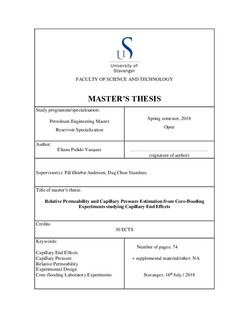| dc.contributor.advisor | Andersen, Pål Østebø | |
| dc.contributor.advisor | Standnes, Dag Chun | |
| dc.contributor.author | Pulido Vasquez, Eliana | |
| dc.date.accessioned | 2018-10-29T09:14:46Z | |
| dc.date.available | 2018-10-29T09:14:46Z | |
| dc.date.issued | 2018-07 | |
| dc.identifier.uri | http://hdl.handle.net/11250/2569887 | |
| dc.description | Master's thesis in Petroleum Engineering | nb_NO |
| dc.description.abstract | Abstract
Relative Permeability and Capillary Pressure Estimation from Core-flooding Experiments studying Capillary End Effects
Relative permeability (Relperm) and capillary pressure (Cp) are fundamental input parameters to describe multiphase flow in a reservoir. Calculation of permeability and capillary pressure may be affected by Capillary End Effects (CEE) as a result of a significant change of capillary properties at the outflow face of the core. The outlet is characterized by zero capillary pressure. It induces the wetting phase to be trapped near the end of the core, leading to incorrect estimation of parameters such as saturation distribution and pressure drop. In this experiment, the core plugs were artificially treated to alter their wettability into more oil-wet conditions. It sought the oil phase to be trapped at the outlet end and then be recovered by step-wise increasing rates.
A procedure for measuring RelPerm and Capillary Pressure over the whole saturation range was used to study CEE. Capillary pressure data were collected from spontaneous and forced imbibition laboratory experiments, and Relperm curves were estimated by history matching of experimental oil production and pressure drop by using the simulator Sendra. End effects were seen when relying on a deliberate procedure that involves low flow rates, long periods of injection, and unsteady state method. Such End Effects were observed through gradual increments of oil production after a change in rate, especially at low rates. Vanished CEE were perceived when using higher rates even though those effects were not completely removed. These observations allow to conclude that waterflooding under unsteady state method is a rate-depend process when accounting for capillary end effects. | nb_NO |
| dc.language.iso | eng | nb_NO |
| dc.publisher | University of Stavanger, Norway | nb_NO |
| dc.relation.ispartofseries | Masteroppgave/UIS-TN-IEP/2018; | |
| dc.rights | Attribution-NonCommercial-NoDerivatives 4.0 Internasjonal | * |
| dc.rights.uri | http://creativecommons.org/licenses/by-nc-nd/4.0/deed.no | * |
| dc.subject | petroleumsteknologi | nb_NO |
| dc.subject | petroleum engineering | nb_NO |
| dc.subject | capillary end effects | nb_NO |
| dc.subject | capillary pressure | nb_NO |
| dc.subject | relative permeability | nb_NO |
| dc.subject | core-flooding laboratory experiments | nb_NO |
| dc.title | Relative Permeability and Capillary Pressure Estimation from Core-flooding Experiments accounting for Capillary End Effects. | nb_NO |
| dc.type | Master thesis | nb_NO |
| dc.subject.nsi | VDP::Teknologi: 500::Berg‑ og petroleumsfag: 510::Petroleumsteknologi: 512 | nb_NO |

